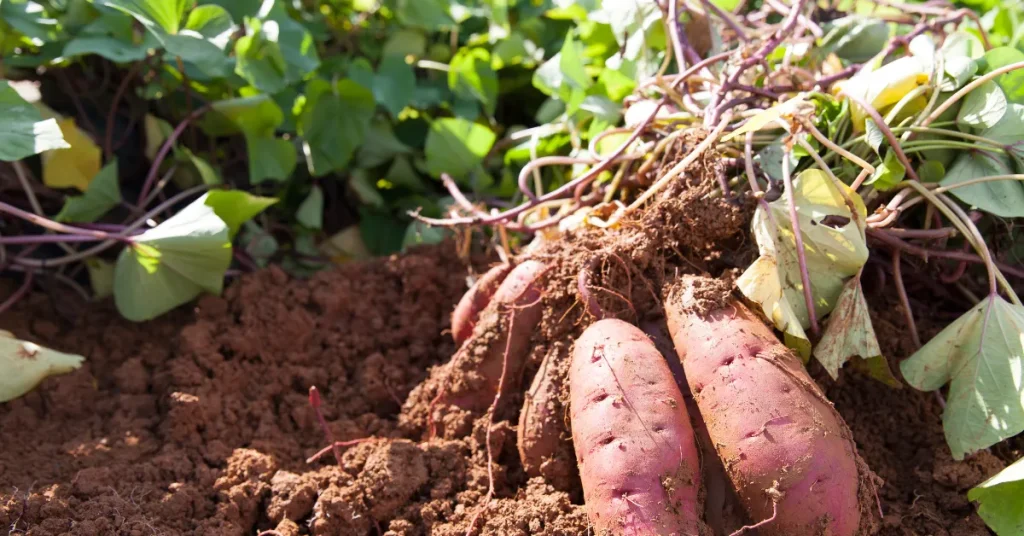Sweet potato roots typically grow 4 to 12 inches deep in the soil. Their roots can spread horizontally up to several feet.
Sweet potatoes are a nutritiously rich root vegetable highly favored for their versatility and sweet, creamy flavor. Thriving in well-drained soil and warm climates, they form part of the morning glory family.
Gardeners and commercial growers alike appreciate sweet potatoes for their relatively low maintenance and ability to grow in various soil types, although they prefer sandy loam.
Cultivation involves planting slips, which are sprouts developed from mature sweet potatoes, ensuring they have the warmth and space needed to expand.
Understanding the growth pattern of sweet potatoes is essential for both efficient harvesting and ensuring optimal yield.

Sweet Potato Basics: Unearthing The Facts
Are you keen to dig into the world of sweet potatoes? These colorful tubers pack a punch of flavor and nutrition. They thrive under the earth, but just how deep do they nestle into the soil? Let’s uncover the growth secrets of these underground treasures.
Sweet Potato Botany And Growth Patterns
Sweet potatoes are not like regular potatoes. Their roots spread out to form tasty tubers. These warm-weather plants prefer long sunny days. They send vines across the ground, with tubers forming at the root nodes.
- Botanical name: Ipomoea batatas
- Type: Root vegetable
- Plant family: Morning glory (Convolvulaceae)
- Growth duration: 90 to 170 days
Roots can grow 4 to 12 inches deep. Each plant can spread several feet wide. Growers need to provide ample space for tubers to expand.
Comparing Varieties: Depth Variances
Not all sweet potatoes are the same. Depth and size vary among varieties.
| Variety | Color | Average Depth |
| Beauregard | Orange | 6-8 inches |
| Jewel | Orange | 5-8 inches |
| Japanese | Purple | 4-6 inches |
| White | Cream | 6-12 inches |
Choosing the right variety is crucial. Consider your climate and soil type. Sweet potatoes love loose, well-drained soil. With care, they’ll prosper and provide a bountiful harvest.
Below The Soil: The Root System
Sweet potatoes hide their treasures below the ground. The root system of these vibrant tubers spreads secretly under the soil’s surface.
This section delves into the fascinating world beneath, where the magic of growth takes place. Let’s unearth the mystery of how deeply sweet potatoes grow and the roots that feed us.
Anatomy Of Sweet Potato Roots
The roots of sweet potatoes are unique. They form starchy tubers we love to eat. Most importantly, the tuberous roots are the thickened parts that store nutrients. Thin, hair-like roots spread out from the tuber. These smaller roots absorb water and minerals from the soil.
- Primary Roots: These are the initial roots that grow directly from the seedling. They dive down into the soil and sprout lateral offshoots.
- Secondary Roots: Offshoots from the primary roots, spreading outwards, they stabilize the plant and absorb nutrients.
- Storage Roots (Tubers): These roots thicken and store food, becoming the sweet potatoes we harvest.
Factors Influencing Root Development
Different factors affect how sweet potato roots grow. Let us consider some key elements:
- Soil Type: Light, well-drained soil allows roots to expand easily.
- Water Availability: Regular, consistent watering supports steady growth.
- Temperature: Warm soil is ideal for root development.
- Nutrient Levels: Balanced nutrients in the soil help roots thrive.
- Space: More room means larger sweet potatoes.
| Factor | Effect on Root Development |
| Soil Density | Compacted soil can restrict growth. |
| Moisture Level | Too much or too little water can impede growth. |
| pH Balance | Extreme pH levels can be harmful to roots. |
| Weed Competition | Weeds can steal nutrients and space from roots. |
The Depths Of Cultivation: Sweet Potatoes Underground

Discovering the depths where sweet potatoes thrive requires both knowledge and curiosity. Below the surface, these nutritious tubers grow stealthily, yet understanding their subterranean world is pivotal for a successful harvest.
Grasping the depths of cultivation offers valuable insights for gardeners and farmers alike.
Typical Depth Range For Sweet Potatoes
Sweet potatoes prefer loose, well-draining soil to expand and develop. Most sweet potatoes will grow within a specific depth range, which can be surprising.
- Top Soil Sweetness: Usually, 4 to 12 inches below the surface.
- Root Reach: Horizontal roots can spread 12 to 18 inches from the plant.
- Depths Differ: Soil type and variety influence how deep they go.
Experiments And Records: Measuring Root Growth
It’s fascinating to chart the growth patterns of sweet potatoes underground. Researchers conduct experiments to track how different factors impact root development.
| Experiment Type | Measurement Focus |
| Controlled Planting | Root depth in varying soils |
| Time-Lapse Recording | Growth rate over time |
| Soil Composition Analysis | Effects of nutrients on depth |
These scientific endeavors aid in maximizing yield and understanding the underground life of sweet potatoes. Home gardeners can also measure and record their crops’ growth to gain personal insights.
Affecting The Abyss: Environmental Impact
Sweet potatoes are a popular and nutritious root vegetable. Yet many of us don’t think about how they grow.
The environment plays a huge part in this. Today, we dig into the effects of our surroundings on the depth at which sweet potatoes grow.
Soil Conditions And Their Influence On Depth
Soil is like a home for sweet potatoes. The right soil lets them grow deep and strong. Let’s look at what ‘right soil’ means.
- Texture: Loamy soil is best. It’s like a soft bed for roots.
- Compaction: Hard soil is no good. It’s like a tight room with no space.
- Drainage: Water must escape. Roots shouldn’t swim in water for long.
- pH Level: Sweet spot is 5.5 to 6.5. Like humans, roots need balance.
Sweet potatoes reach down more in soft, loamy, and well-drained soil. Good soil means deep roots and bigger potatoes.
The Role Of Climate In Root Growth
Climate tells roots how to grow. Sun, water, and temperature are like traffic signs for them.
| Climate Factor | Effect on Root Growth |
| Sunlight | More sun equals more food for growth. |
| Moisture | Just right amount means no dry or waterlogged roots. |
| Temperature | Warmth tells roots it’s time to grow deep. |
In short, a warm, not too wet, and sunny climate makes perfect roots. They can dig deep looking for water and nutrients. Each of these environmental aspects works together. They influence how healthy and deep sweet potatoes will grow.
Harnessing The Harvest: Techniques For Deeper Yields
Harnessing the Harvest: Techniques for Deeper Yields dives into the art of maximizing sweet potato growth.
For gardeners and farmers alike, understanding the secrets to richer, more abundant sweet potato yields can mean the difference between a good harvest and a great one. Read on to discover how to go deeper with your sweet potato crops.
Agricultural Practices For Optimal Root Depth
Successful sweet potato cultivation starts with the right techniques. Follow these practices to encourage extensive root development:
- Soil Preparation: Before planting, ensure proper tilling. Deep, loose soil allows roots to penetrate further.
- Spacing: Space plants optimally. Crowded plants can’t stretch their roots deep down.
- Watering Strategy: Apply water at the root level. Drip irrigation brings moisture down, attracting roots deeper.
- Nutrient Management: Balanced fertilization promotes healthy root growth without surface dependency.
- Varietal Selection: Some varieties dive deeper. Choose ones known for their long taproots.
Innovations In Sweet Potato Farming
New technologies pave the way for deeper sweet potato yields. Here’s a snapshot of innovations transforming the farming landscape:
| Innovation | Impact |
| Subsurface Drip Irrigation | Delivers water directly to roots, encouraging deep growth. |
| Biodegradable Mulch Films | Preserves soil moisture, inspiring roots to seek water lower down. |
| Raised Beds and Ridges | Improves drainage, promotes downward root expansion. |
| Precision Agriculture Tools | Ensures ideal planting conditions for maximum root penetration. |
Integrating these advancements with tried-and-true practices enhances sweet potato crops substantially.
Beyond The Farm: Sweet Potato Applications

Sweet potatoes are not just underground treasures; their journey from the soil’s depths to our tables is remarkable. Let’s dive into how deep-grown sweet potatoes enrich our lives beyond the fields.
Culinary Exploits Of Deep-grown Sweet Potatoes
Grown beneath the surface, these vibrant tubers offer an array of delightful dishes. They pack flavors and textures that are unmatched.
- Baked to perfection for a comforting side dish.
- Mashed for a rich and creamy treat.
- Spiralized as healthy noodles for a twist on classic pasta.
In desserts, deep-grown sweet potatoes bring natural sweetness and moisture to pies and breads.
Their depth of flavor intensifies with each scoop of earth they break through. Think of a sweet potato grown six inches deep versus one that’s found twelve inches down—it’s all about that rich, earthy essence!
Nutritional Benefits Linked To Root Depth
The depth where sweet potatoes grow impacts their nutritional value. Deeper roots may access more nutrients, affecting the tuber’s quality.
| Depth | Nutritional Advantage |
| Shallow Grown | Standard vitamin content |
| Deep Grown | Enhanced mineral uptake |
Antioxidants and vitamins flourish in deep-grown varieties. These nutrients contribute to our overall health, potentially offering better immune support and disease prevention.
- Higher vitamin A for better eye health.
- Increased beta-carotene for improved skin vitality.
- Ample fiber supporting digestive wellness.
Each plunging root picks up unique minerals that can enhance the sweet potato’s beneficial compounds. This is why depth matters—not just for the crop yield, but for nourishing our bodies.
FAQs About How Deep Do Sweet Potatoes Grow
What Is The Typical Depth For Sweet Potatoes?
Sweet potatoes usually grow 4 to 12 inches deep. Their sprawling roots spread out shallowly in the soil. Proper cultivation ensures optimal depth for healthy tubers.
Can Sweet Potatoes Grow In Shallow Soil?
Yes, sweet potatoes can grow in shallow soil. They are adaptable and can thrive even with 8 to 10 inches of soil. However, deeper soil promotes larger tubers.
How To Maximize Sweet Potato Tuber Growth?
Maximizing tuber growth requires loosened soil, proper spacing, and adequate water. Aim for 12 to 18 inches between plants in rows spaced 3 to 4 feet apart.
Does Soil Type Affect Sweet Potato Depth?
Sweet potatoes prefer sandy loam soil for deep growth. Clayey or rocky soil restricts tuber expansion, leading to shallower and smaller sweet potatoes.
Conclusion
Understanding the growth patterns of sweet potatoes can significantly enhance your gardening success. These tubers typically nestle 4 to 12 inches underground, a depth crucial for their development.
Remember, optimal soil conditions and proper care yield the healthiest crop. Get ready to dig deep, but not too far, for those delicious, home-grown sweet potatoes.
Happy gardening!
Resources:
1. https://extension.psu.edu/sweet-potatoes-a-winning-vine-for-your-garden
